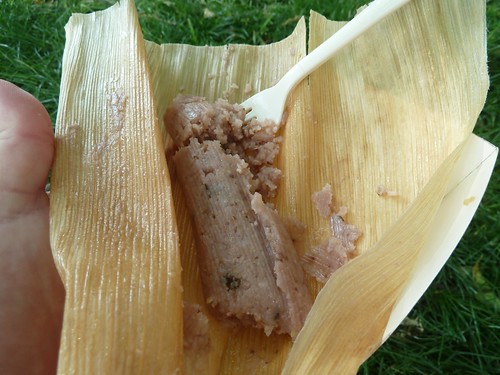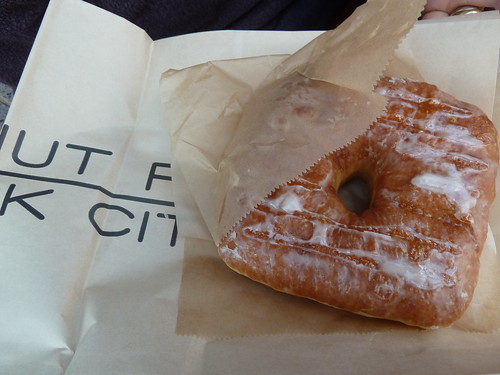David Tamarkin has an anti-locavorism piece up at Time Out, prompted by the current Green City locavore challenge, that very convincingly argues against… a type of person I have never met in real life. Maybe they exist, maybe there are doctrinaire locavores like there are militantly humorless vegetarians. (No, I didn’t just say all vegetarians are militant and humorless, but I know those exist because they responded in the comments to this.)
As I say, maybe absolutist locavores exist. But I have yet to meet any.
Tamarkin’s argument is basically founded on this:
People who become localvores—whether for two weeks or 200—are likely well-intentioned, considerate citizens of the Earth. They choose to eat locally for two main reasons: (1) They believe it’s better for the local economy—the money spent on local food ostensibly goes to local farmers, thereby helping those farmers thrive and keeping the area flush with crops and money; and (2) They believe eating locally is better for the environment (in theory, local foods eliminate the need for long, gas-guzzling deliveries and high-emission plane rides). In short, localvores make sacrifices, severely limiting what they eat for the benefit of the land and the people around them.
Sorry, you lost me at your basic premise. Yes, locavores would like to do both of these things, and undoubtedly feel good (and sometimes smug) about it. But first and foremost, every high-profile locavore I know eats locally first because it tastes good. In-season fruit or vegetables grown a short distance away, as a class, taste 100 times better than stuff that’s been bred primarily to survive the flight from Chile in visually pristine condition. Farmer’s market eggs beat Jewel ones. Chicken tastes like chicken. Beef tastes like beef. Peaches taste like childhood. Grapes taste like wine. Without that, none of the locavores I know would follow it for two weeks. But the fact is, the principles underlying local eating are the principles that result in better-tasting produce. Far from being severely limited, locavorism seems fundamentally rooted in sensual pleasures.
That these principles do some good, kind of probably maybe, is a bonus. Tamarkin trots out some contrarian arguments suggesting that a peach that flies in on a 707 is better for the planet than one that drove down from Michigan. But even if that’s true, the peach will still suck. So put me on the record right now as someone who will still be buying local peaches even if each one kills a polar bear and melts a fjord.
But in fact, I find the contrarian arguments stoned-dorm-room-discussion sophomoric:
If the first goal of buying local produce is to help farmers in need, it would stand to reason that localvores should seek out the neediest farmers they can. If they did, they would not find them in an incredibly wealthy nation like ours. As philosopher Peter Singer and cowriter Jim Mason write in The Ethics of What We Eat (Rodale, $15.95), the profits a farmer in a developing country earns from selling his wares in America—even if it’s as little as two cents—will go further toward helping that farmer combat poverty than those profits would for a Midwestern farmer. “A decision to buy locally produced food,” Singer and Mason write, “is a decision not to buy food from countries that are significantly worse off than our own.”
And you know what? My son can already read pretty well, and it seems like he has a pretty decent moral sense for a 9-year-old. So it stands to reason that I should seek out the neediest housing project children I can, and raise them instead.
There’s a fine movie from the 1930s about Weimar Germany called Little Man, What Now?, in which one of the supporting characters is a socialist crank who supposedly loves humanity— but can’t be bothered to adequately care for his own wife, who eventually sickens and dies of neglect. It’s absurd to think that I have to scour the world for the peach from the absolute worst-off farmer— and help him a little and a shipping company a lot— or else admit I’m a hypocrite. That’s a real example of the kind of hypernarrow absolutism that no locavores I know actually practice. It is enough that I can help a farmer, and eat a better peach, and all in all it was a good thing, whether or not it was the best possible thing. Il faut cultiver notre jardin.
One of the sillier tendencies Baby Boomers have is to hyperdramatize every choice in life. The reality is, the darkness will not descend if either McCain or Obama is elected or not elected, the oceans will not boil if you drive to the video store and will not be saved if you watch An Inconvenient Truth, etc. etc. And eating a Michigan peach or a Chilean one is not a momentous decision for the planet. That said, that real farmer at Green City puts your real money in his pocket, and keeps more of it than if he sold his product to a distributor. So you and he can benefit directly from that act. It can matter to the two of you, even if it doesn’t matter to the whole world. And frankly, I’m fine with helping a human, over worrying about helping humanity.
What Tamarkin surely knows but isn’t going to admit in the midst of making the case for the prosecution is that the point of the two-week Green City challenge isn’t that everyone will keep it up forever and absolutely. That’s proven by the fact that it’s timed to exactly when the market is flooded with the most choices, and being a locavore is easiest and most appealing. But a two-week trial gives you a chance to try a lot of things and incorporate a few into your diet and be more likely to seek out superior-tasting market produce on a more regular basis. This is the kind of locavorism that is small-scale, individual, and makes your life and maybe, possibly, in some fraction of the Adam Smith invisible hand way, the world a tiny bit better place.
The more extreme kind of locavorism is not like that. And if I ever meet a person who actually believes in it, I’ll tell them that.
UPDATE: Although part of my point is that it’s NOT necessary to research every last consumer decision you make to death, that the act of buying good-tasting stuff from a real farmer is good enough, there’s a comment at Chicagoist that provides some solid facts about the Peter Singer notion of aiding the world’s poorest farmer or else don’t even bother. It’s here.
UPDATE 2: Tamarkin has some more comments on the TOC blog. He seems so keen on this notion of the absolute locavore that I guess we have to accept that he’s really met this mythical creature, but I haven’t and I just don’t take the whole notion seriously, maybe I’ve met enough people in my life who’ve found The Answer (whatever it is this week) and bore everybody to death with it. But again, the locavores I know aren’t like that, or this:
Localvores take the thinking out of their food choices in favor of being part of a movement; the only requirement for eating something is where it was produced, so not a lot of thought is required.
Again, couldn’t be more unlike the locavores I know, who think hard about what will be best and what to do with it for maximum flavor. Just read this LTHForum thread, for instance.
Eating locally is a principle, not a fatwa, which is to be followed for its obvious and direct benefits. And again, I find something sort of narcissistic about this boomer compulsion to make the best possible choice for the planet, or don’t even try. The local movement educates you to some major components of why things taste good when, and gives you a principle that leads you to putting money directly in farmers’ hands. The more people who do that, the better it is for farmers, health and maybe the environment. More good will come from more people partially following a good general principle than a few people rigidly following a dogma.
Maybe Tamarkin just needs to meet some different locavores….
Tags:
david tamarkin,
green city market,
Local,
time out






 Posted in
Posted in 








